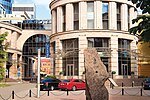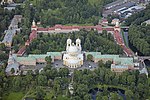Ploshchad Vosstaniya (Saint Petersburg Metro)

Ploshchad Vosstaniya (Russian: Плóщадь Восстáния, IPA: [ˈploɕːɪtʲ vɐsːˈtanʲɪjə], lit. Uprising Square) is a station on the Kirovsko-Vyborgskaya Line of Saint Petersburg Metro. It is one of the system's original stations, opening on November 15, 1955. It is a deep underground pylon station at 58 metres (190 ft) depth. The main surface vestibule is situated on Vosstaniya Square, which gives its name to the station. Another exit (opened in 1960) opens directly into the Moskovsky Rail Terminal. Ploshchad Vosstaniya is connected to the station Mayakovskaya of the Nevsko-Vasileostrovskaya Line via a transfer corridor and a set of escalators.
Excerpt from the Wikipedia article Ploshchad Vosstaniya (Saint Petersburg Metro) (License: CC BY-SA 3.0, Authors, Images).Ploshchad Vosstaniya (Saint Petersburg Metro)
площадь Восстания, Saint Petersburg Peski (округ Смольнинское)
Geographical coordinates (GPS) Address Nearby Places Show on map
Geographical coordinates (GPS)
| Latitude | Longitude |
|---|---|
| N 59.9316 ° | E 30.3605 ° |
Address
площадь Восстания 2
191036 Saint Petersburg, Peski (округ Смольнинское)
Saint Petersburg, Russia
Open on Google Maps











